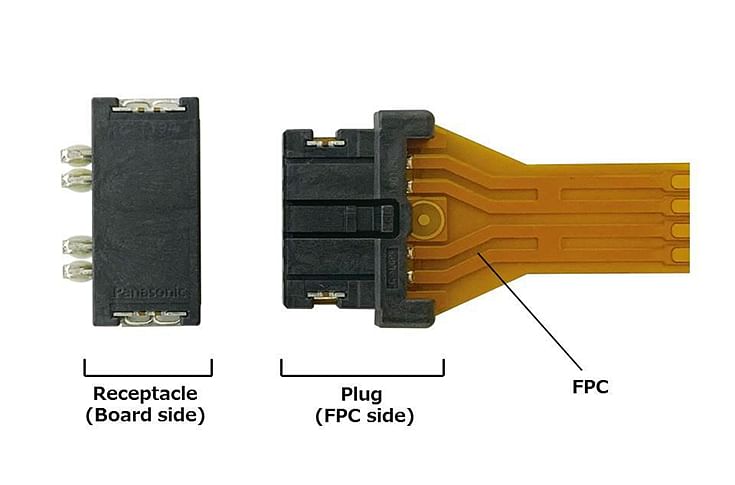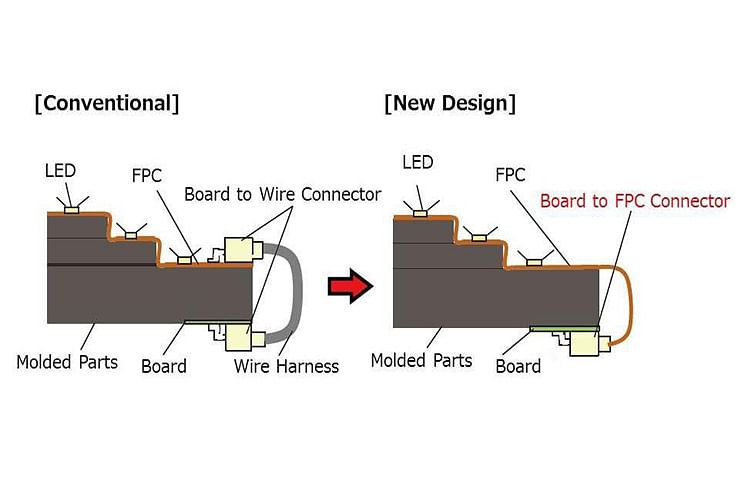Panasonic to mass produce new ‘Board to FPC connector’
Panasonic’s new connector eliminates the need for wire harnesses previously needed for connection, allowing the use of fewer components and fewer assembly person-hours, as well as enabling vehicle weight reduction and therefore lower fuel consumption.
Panasonic Corporation announced today that it will launch full-scale mass production of a ‘Board to FPC Connector’. The new connector allows the use of fewer components and fewer assembly person-hours for vehicles, as well as making room for improved design of automotive LED lights, and similar other applications.
Due to the increasing use of DRLs (daylight running lamps) following changes in the law governing automotive LED lights in Europe and Japan in recent years and improved designs for vehicle compartment instrument panels, and many more demand for automotive FPCs is expected to grow, accompanied by greater use in cable connection applications such as BMSs. Panasonic has designed and commercialised a connector with a unique structure that allows direct connection between the automotive FPC and the board. This connector eliminates the need for wire harnesses previously needed for connection, allowing the use of fewer components and fewer assembly person-hours, as well as enabling vehicle weight reduction and therefore lower fuel consumption.
According to Panasonic, the unique metal terminal connection structure, which allows direct connection between the FPC and the board, eliminates the need for relay harnesses, allowing the use of fewer components and assembly person-hours. Although FPCs and boards are conventionally connected mainly by using relay harnesses or by soldering FPCs and boards, there are drawbacks such as the additional weight and poor assembly workability of wire harnesses. By adopting a unique structure that allows direct connection between the FPC and the board, this connector eliminates the need for relay harnesses, allowing the use of fewer components and assembly person-hours.

Connector structure
The connector's double-clip contact structure achieves excellent resistance to vibration, making it compatible with automotive applications such as LED lights and BMSs. Automotive connectors are required to meet strict vibration criteria. According to Panasonic, this connector has achieved excellent resistance to vibration by adopting a unique double-clip contact structure that reliably grips the plug, i.e., the metal terminal (FPC side), and the receptacle (board side). The connector can also be used for FPCs for connecting BMS battery packs and boards, as well as for LED lights that require resistance to vibration.
The connector's inertial lock structure prevents incomplete engagement, achieving high reliability. The connector, which is a two-piece type consisting of a plug (FPC side) and a receptacle (board side), is designed for easy connection. Furthermore, the connector has achieved high reliability by adopting an inertial lock structure capable of preventing incomplete engagement between the receptacle and plug during assembly.

Comparison of connection methods
Panasonic claims that the new connectors are apt for Cable connection for DRLs (headlamps), rear lamps, side mirrors, instrument panels, shift levers, steering switches, BMSs, cameras, and similar others.
RELATED ARTICLES
Skoda begins sale of made-in-India CKD Kushaq in Vietnam
Before production started, pre-series Kushaq vehicles covered over 330,000 kilometres on a variety of Vietnamese roads a...
Six Japanese companies join forces to expand use of recycled materials in new vehicles
Denso, Toray Industries, Nomura Research Institute, Honda Motor, Matec Inc and Rever Corporation have set up the BlueReb...
BYD selects Voestalpine as steel supplier for its Hungarian plant
The announcement of the Austrian steelmaker as a supplier demonstrates BYD’s strategic plan to source from high-quality,...





 By Autocar Professional Bureau
By Autocar Professional Bureau
 10 Jul 2019
10 Jul 2019
 6276 Views
6276 Views









